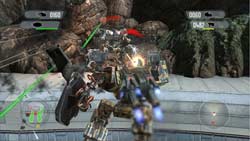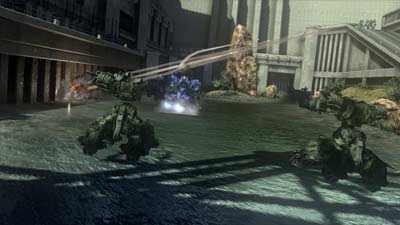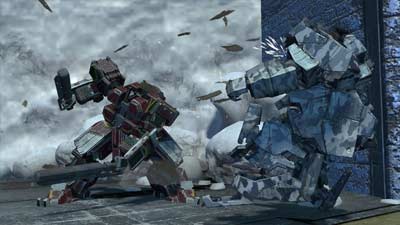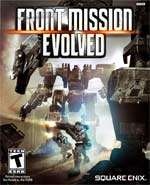Big Robots Blowing Things Up
There’s nothing wrong with tweaking a beloved series to make it more accessible to the general public. Plenty of great games have come from this process. Just think of Resident Evil 4, Splinter Cell: Conviction, or Civilization V.

At some point, however, an adaptation of a franchise is such a departure that it’s not really part of the franchise at all. This is the case with Front Mission Evolved. We understand that Front Mission games haven’t been selling well outside of Japan lately, but if Double Helix wanted to make a third-person mech shooter instead of a tactical RPG, they should have dropped the Front Mission name entirely (as Lara Croft and the Guardian of Light did with the Tomb Raider name). What’s worse, Front Mission Evolved doesn’t even work that well as a third-person shooter.
As the game begins, it’s 2171 on Long Island, and the human race’s latest project is to build “orbital elevators” that spy on their rivals in space. You step into the shoes of Dylan Ramsey, a civilian engineer who designs mechs for a living. He’s testing out a new “wanzer” when he learns that a rival faction has attacked an orbiter that’s near where his father, a scientist, works. He sets out in his creation to make sure his dad is okay. Unfortunately, the enemy destroys the building his father works in, and his father is unable to escape. Ramsey decides to seek revenge.
As you attempt to get Ramsey some payback, you encounter three different types of gameplay. The first (and most common) involves merely mowing down enemy robots from the relative safety of your mech. Your machine controls smoothly for the most part, and you have an impressive range of options for killing your foes. You can shoot them with a variety of guns, blast them with heat-seeking missiles, or even backhand them with melee attacks. In addition, you can move quickly for brief periods of time to traverse long distances and evade attacks; sometimes, you’re given extended use of this mechanic so you can speed through obstacle courses. Early in the game you gain access to the E.D.G.E. system, which heightens your awareness, slows down time, and allows you to inflict more damage.

This basic setup could have lent itself to a phenomenally fun game, but the level design keeps that from happening. In the end, this is more or less an arcade shooter: you simply walk (clank, clank, clank) from one waypoint to another, blasting whatever happens to get in your way, and hiding behind cover whenever you get the chance. While your different methods of attack give you some tactical options, the mech sequences begin to feel stale in a hurry.
In fact, most of the actual strategizing for these sequences happens in between levels, when you decide what setup you’ll use. The range of options is initially impressive; you can choose from a variety of weapons, skills, and armor, and you can customize your mech’s paint job. If you want, you can even put one weapon in each hand and two more on your shoulders. However, you quickly realize that as awesome as a mech equipped with four huge guns would be, it’s not really an option, because your mech has a weight limit. This makes customization a chore, and we normally just went with one of the pre-built mechs instead of trying to build something from scratch. Further, the sniper rifle is dramatically overpowered, so equipping it is half the battle.

You’ll also face numerous bosses in your mech. Unfortunately, though, the boss fights are one of the game’s worst features. Most of the battles are manageable in terms of difficulty, thanks to the regenerating health packs that can usually be found nearby, but they drag on for inordinate amounts of time, sometimes fifteen minutes or more. The worst thing a boss fight can do is put the player to sleep, and that’s exactly what happens here.
For the second type of gameplay, Dylan hops out of the mech and engages in some on-foot shooting sequences. Unfortunately, these just make the game feel like a third-rate Gears of War knockoff. The cover system, if you can call it that, consists of standing behind cover and hitting the duck button. Also, the controls feel clunky, but this doesn’t make things more difficult, thanks to the awful enemy AI and generous auto-aim.

The third type of gameplay has you firing at ground targets from an on-rails aircraft. These sections are fun, but hardly ground-breaking.
There are some collectibles to find strewn about the levels, which will give completionists a reason to replay the roughly eight-hour campaign. You can also ramp up the difficulty. However, we doubt that many players will feel compelled to retread the uninspired ground contained here, so these features are of limited value.
The multiplayer modes, meanwhile, are little more than cliches: there’s deathmatch, team deathmatch, a mode where you fight to control turrets, and a King of the Hill-type mode where you try to control a single location on the map. The tactical choice between ranged attacks and melee combat come into play much more than they do during the single-player campaign, but this is still an arcade-style experience with middling level design. Fellow players take far too much damage before they die, and there are too many powerups strewn about which causes deathmatches to drag on almost endlessly. A Call of Duty-style leveling system spices things up a bit, but as always, this has the perverse effect of giving the most experienced players an even bigger advantage over newbies than they already have by nature. Fortunately, though, there’s little to no lag, and we had no problem setting up matches.
The presentation is mediocre to good. The graphics run smoothly, and the mechs and explosions look great. However, the various environments (the game takes you all over the world) aren’t very detailed and don’t look all that futuristic, and the character models in the cutscenes are bare-bones. The sound effects are a high point here, bringing out the giddy thrill of metal-on-metal warfare. Much of the voice acting, meanwhile, is downright terrible; during the opening sequence, we were embarrassed for whatever “actor” read the voiceover.
All told, Front Mission Evolved is a bizarre step for the Front Mission series to take; it will simultaneously alienate longtime fans and fail to attract newcomers. Hardcore devotees of the franchise, or of mechs in general, will probable give it a shot anyway, and they might enjoy some of the arcade-style shootouts. But no one will consider this to be a standout game for 2010, and given Front Mission’s storied history, it should have become so much more when it “evolved.” We recommend passing on this one, but if you must try it, start with a rental.
RATING OUT OF 5 RATING DESCRIPTION 3.5 Graphics
Everything runs smoothly, and the mechs look nice, but the environments and character models lack detail. 3.7 Control
The mechs control well, but when your character steps out for a few on-foot segments, the going is pretty rough. 3.4 Music / Sound FX / Voice Acting
Great sound effects, but the voice acting leaves something to be desired. 3.2 Play Value
There’s an eight-hour campaign that includes some collectibles, plus multiplayer modes, but the gameplay isn’t compelling enough to make you want to return. 3.3 Overall Rating – Fair
Not an average. See Rating legend above for a final score breakdown.
Game Features:
